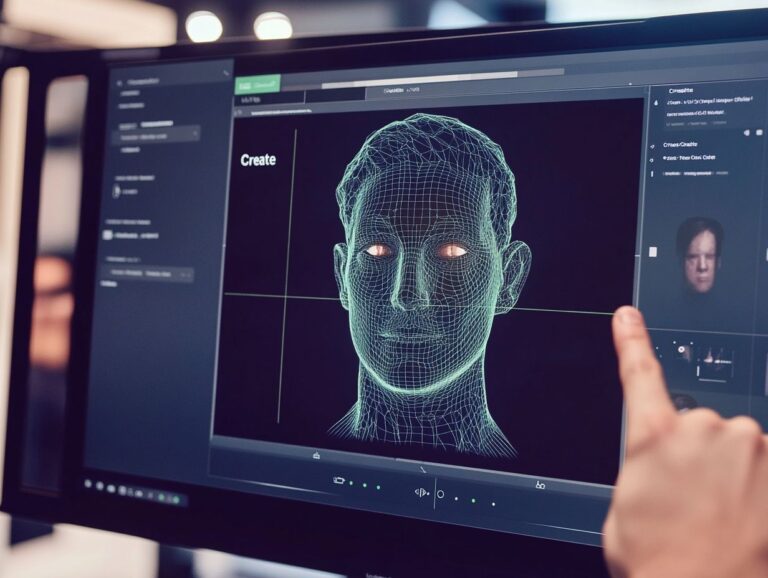How to Describe an Image Using AI?
In today’s increasingly visual world, the ability to interpret and describe images is becoming essential, particularly with the rise of social media and e-commerce. Image Description AI is revolutionizing how we engage with visual content by providing solutions that enhance accessibility, improve SEO, and save time for content creators. However, there are challenges to consider, including concerns about accuracy and cultural sensitivity. This article explores what Image Description AI is, how it works, its benefits and challenges, and its practical applications across various industries. Discover how this tool can transform engagement with images and empower users with diverse needs.
Contents
Key Takeaways:

- Image description AI provides accessibility for visually impaired individuals, saving time for content creators, and improving SEO for images.
- Challenges of image description AI include accuracy and understanding of context, as well as limited language and cultural awareness.
- Image description AI can be used for social media, e-commerce, education, and accessibility features, among other applications.
What Is Image Description AI?
Image Description AI refers to a type of artificial intelligence (AI) that utilizes advanced computer vision technologies to analyze and interpret images, generating accurate descriptions of visual content. In recent years, Image Description AI has experienced rapid growth due to its diverse applications across various industries, including e-commerce and social media. These applications enhance user experiences by automatically providing contextual insights about images and their attributes. As the technology behind image description AI has advanced, platforms such as Azure AI Vision, Pallyy, and Google Vision API have emerged, enabling users to automatically generate and apply image descriptions to their visual data. Automated image description AI tools offer several benefits, including improved accessibility for visually impaired users who rely on audio descriptions of images, as well as enhanced metadata for content that can boost search engine optimization (SEO) capabilities.
What Are The Benefits Of Using Image Description AI?
Image Description AI offers several benefits, including enhanced accessibility for visually impaired individuals, improved SEO for images across digital platforms, and savings in time and resources for content creators by automating the image description process. Additionally, it provides metrics on image features and contextual relevance, leading to improved engagement and interaction with users, particularly in the realms of e-commerce and social media.
1. Accessibility for Visually Impaired Individuals
One of the most significant benefits of Image Description AI is its ability to enhance accessibility for visually impaired individuals by providing detailed image descriptions that improve their interaction with visual content. These descriptions enable users to understand the context and features of images, granting them access to digital content that they might not otherwise be able to enjoy. This is crucial because it ensures that visual content on various platforms is inclusive and helps break down barriers, leading to a more equitable online ecosystem. Moreover, this technology give the power tos visually impaired users by allowing them to navigate and interpret digital landscapes in a way that is comparable to their sighted counterparts. The descriptions go beyond merely detailing aesthetic features; they also convey the emotions and narratives that the images communicate, resulting in a richer engagement with the content. The societal implications are substantial, as these advancements represent a step toward creating a truly inclusive society where all individuals have access to information and can fully participate in the digital conversations of our time. As AI continues to develop its capabilities, it will increasingly enhance accessibility, ensuring that the benefits of technological advancements are extended to the experiences of visually impaired individuals.
2. Time-saving for Content Creators
AI-driven image description technology significantly enhances the efficiency of content creators by automating the process and allowing them to focus on other important aspects of content creation. Manual image description can be laborious and time-consuming; however, AI tools can generate fast and accurate contextual descriptions within seconds. This automation streamlines workflows across various sectors, particularly in e-commerce and social media. As even more productivity-enhancing AI tools are developed for image description, content creators will be able to concentrate on more complex tasks, resulting in improved quality and consistency of image metadata. For instance, a fashion retailer can upload product images and receive AI-generated descriptions in seconds, detailing the color and style of the item as well as the appropriate occasions for wearing it. Similarly, social media marketers can input an image and receive a catchy caption that aligns with their brand and is suitable for blind or visually impaired users within seconds. This type of AI assistance minimizes repetitive tasks and enhances the overall quality of output.
3. Improved SEO for Images
Optimizing image descriptions with Image Description AI positively impacts SEO, as search engines increasingly rely on contextual and accurate metadata to rank visual content such as photos and images. By improving visual materials with relevant keywords and detailed description tags generated by AI, users can improve the likelihood of their images being discovered through search engines like Google. This recognition of image features and context benefits both search indexing and user experience by enhancing the quality of relevant search results. The use of AI in generating image descriptions enables consistent and rich metadata production with minimal manual effort. This technology analyzes the visual characteristics of an image, allowing it to create descriptive captions that incorporate keywords relevant to the image’s subject. When these AI-generated descriptions align closely with user search queries, they not only enhance visibility on search engines but also significantly boost user engagement, as users are more likely to find and interact with content that meets their needs. In a digital landscape where attention is limited, optimizing image descriptions with AI can make a meaningful difference.
What Are The Challenges Of Image Description AI?

1. Accuracy and Understanding of Context
The accuracy of Image Description AI heavily relies on its ability to recognize context effectively. Misunderstanding context can result in inaccuracies in image descriptions, which may mislead users about the actual content of the image and diminish the utility of AI-generated descriptions. Contextual recognition is a critical factor in the overall quality of image descriptions, particularly in challenging scenarios. For example, an AI system may recognize a man holding a flower as simply a man standing in a garden, failing to interpret the emotional context of the man’s action. Such inaccuracies can have varying consequences for different users; in fields like medical imaging or security analytics, an incorrect description could lead to poor decision-making. Developers can address these issues by employing multimodal learning approaches, which leverage additional data sources, such as text associated with images or user feedback, to enhance the AI’s interpretation of images. Furthermore, creating a more comprehensive training dataset that includes a broader range of contextual examples can improve the AI s contextual understanding, which is essential for producing high-quality descriptions.
2. Limited Language and Cultural Awareness
Limited language and cultural awareness in Image Description AI can lead to descriptions that fail to resonate with diverse audiences, ultimately affecting engagement with visual content. AI systems may not fully understand cultural nuances or idiomatic expressions, resulting in descriptions that lack depth or relevance. This issue not only affects individuals seeking clear and accurate descriptions but can also diminish overall sentiment toward AI technology. Such disconnects may cause users to feel alienated or misunderstood, which detracts from their experience. To enhance cultural sensitivity and language capabilities, developers should collaborate with multicultural teams that can provide insights into various cultural contexts and preferences. Investing in advanced natural language processing techniques can enable AI systems to interpret idioms and contextual meanings more accurately. Additionally, regularly updating training datasets to include a broader range of cultural representations and vernaculars will ensure continuous improvement. By embracing diversity in language and culture, the effectiveness and relatability of image descriptions can be significantly enhanced, fostering greater user engagement and satisfaction.
What Are The Different Types Of Image Description AI?
There are several types of image description AI, including the following:
- Object Recognition: This type of AI identifies and categorizes specific objects within an image. It analyzes the image to determine the presence and characteristics of various objects, providing valuable metadata that can be utilized in sectors such as e-commerce and digital marketing.
- Scene Recognition: Scene recognition AI examines entire images to offer a comprehensive understanding of the context and setting. It can identify and categorize the overall ambiance of a picture, making it particularly useful for applications in travel and tourism promotion, where the focus is on the environment rather than individual objects.
- Text Recognition: Also known as Optical Character Recognition (OCR), text recognition AI extracts textual information from images and videos. This type of image description AI is primarily focused on analyzing images that contain text, enabling applications in document processing, translation services, and information extraction.
1. Object Recognition and Description
Object recognition and description in Image Description AI involves identifying and labeling specific objects in an image while providing detailed information about their characteristics and context. This functionality is particularly significant for e-commerce applications, as well-crafted product descriptions can greatly influence user engagement and sales. By integrating AI tools with advanced object recognition algorithms, e-commerce businesses can automate the process of generating product descriptions, enhancing their online visibility and accessibility. For instance, when customers shop online, they often rely on visuals to guide their purchase decisions. Image Description AI can assist by automatically generating enriched descriptions that highlight key features such as color, size, and style, thereby increasing the likelihood that customers will find what they are searching for. Additionally, this technology offers visually impaired users audio descriptions of products, creating a more inclusive shopping experience. The quick analysis process and precise descriptions not only boost customer satisfaction but also reduce return rates, ultimately leading to increased sales and brand loyalty.
2. Scene Recognition and Description
Scene recognition and description in Image Description AI refers to the AI’s ability to understand the context of an image, identify key components, and summarize the entire scene. This feature is particularly beneficial for social media applications, where sharing relevant and engaging visual content can enhance user interaction. With the assistance of AI tools specialized in scene recognition, users receive descriptions that closely align with the context of their photos. When a user uploads an image, the AI focuses on significant aspects, such as the people or objects present and the actions taking place, to produce descriptions that immerse viewers in the context of the photo. For instance, a stunning sunset photo may garner attention for its natural beauty, but an AI-generated description can evoke feelings of peace and awe, prompting users to share their own memories or sentiments in response. By providing contextual descriptions that reflect the mood and activities depicted in users’ photos, platforms can foster an environment that encourages deeper connections and interactions among users.
3. Text Recognition and Description
Text recognition and description in Image Description AI involves identifying and extracting textual content from images, enabling users to generate relevant content descriptions. This technology is particularly useful for document scanning and content retrieval, allowing users to access and utilize information more efficiently. By incorporating AI tools with text recognition features, organizations can better manage data and enhance accessibility. The significance of text recognition in this context lies in its ability to transform visual input into valuable insights, fostering improved decision-making and knowledge sharing. For instance, in the healthcare sector, medical professionals can quickly digitize patient records, facilitating accurate data retrieval and enhancing workflow. Educational platforms also leverage text recognition to convert printed materials into digital formats, making learning resources more accessible to students with disabilities. In the realm of digital marketing, brands can analyze visual content shared on social media for sentiment analysis, ensuring their messaging aligns with audience preferences. This approach helps increase engagement and improve the overall customer experience.
How Can You Use Image Description AI?

1. Social Media and Digital Marketing
In social media and digital marketing, Image Description AI is utilized to create engaging captions that describe images in a way that resonates with target audiences. This practice enhances interaction with online content and supports marketing and branding efforts, as people are more likely to engage with emotionally relatable content. Image Description AI technology automatically generates image descriptions, enabling businesses to optimize these descriptions for both search engines and users, particularly those with visual impairments. Accurate descriptions in social media and digital marketing increase the likelihood of establishing a connection between the brand, product, or service and the consumer. Brands have reported significantly higher engagement metrics for posts featuring AI-generated captions. Along with enhancing the consumer experience, Image Description AI technology contributes to the creation of accessible content, allowing businesses to reach audiences that might otherwise miss the content without a screen reader. Companies like Nike and Starbucks exemplify the use of Image Description AI technology to improve their social media marketing campaigns by leveraging AI-generated image descriptions. For instance, they have described images of shoes and drink cups in ways that appeal to visual, auditory, and even gustatory senses. As technology advances, the application of AI in this manner will be crucial for brands to comply with accessibility standards while also improving their SEO, ultimately resulting in better visibility and engagement.
2. E-commerce and Product Descriptions
In the e-commerce sector, Image Description AI significantly enhances the quality and accessibility of product descriptions by automatically generating detailed and accurate descriptions based on images. This capability allows businesses to optimize their online catalogs, improve user experience, and ultimately increase conversion rates by providing customers with clear insights into products. AI tools for image description enable e-commerce platforms to ensure that their visual content is both informative and accessible to all users. For instance, a well-known apparel retailer has successfully integrated AI technology to automatically generate descriptive tags for each item, which has improved the SEO and visibility of their online catalog. As a result, customers can more easily find items with specific attributes such as color or style, thanks to the precision of these descriptions. Similarly, a furniture company has utilized AI to create rich storytelling around their products, enabling customers to envision how items would look in their own homes. These examples illustrate that adopting Image Description AI not only enhances accuracy but also increases user engagement, ultimately driving sales and fostering brand loyalty.
3. Educational and Training Materials
AI for image description plays a vital role in the development of educational and training materials by providing descriptive captions for images, thereby enhancing comprehension and accessibility for all students.
4. Accessibility Features for Websites and Apps
Integrating Image Description AI into websites and applications enhances accessibility features by providing accurate and contextual descriptions of images, ultimately improving usability for visually impaired users. This integration of AI-generated image descriptions enables organizations to create more accessible digital environments, thereby enhancing user experience and ensuring compliance with accessibility standards. By prioritizing accessibility, businesses can reach broader audiences and foster a more inclusive digital presence. For instance, when a visually impaired person visits an e-commerce website, AI can describe not only the appearance of a product but also its features, colors, and textures. This capability give the power tos users to make informed purchasing decisions, similar to those made by individuals without visual impairments. Successful implementations of this technology can be seen in e-commerce giant Amazon and blogging platform WordPress, both of which have experienced increased engagement and satisfaction among visually impaired users. Along with enhancing the user experience, these advancements help to reduce barriers to access, promoting greater equality in the digital realm.
How Accurate Is Image Description AI?
The accuracy of Image Description AI is a crucial factor influencing its overall effectiveness in generating reliable and contextual image descriptions. This accuracy depends on various factors, including the quality of the training data, the complexity of the images, and the algorithms employed by the AI tools. By understanding these factors, users can better grasp the limitations of current technologies and identify potential improvements to enhance the quality of the generated image descriptions.
1. Factors That Affect Accuracy
Several factors influence the accuracy of Image Description AI, including the quality of input images, the diversity of training datasets, and the sophistication of the algorithms employed for image recognition. The accuracy of AI-generated image descriptions tends to improve with high-resolution images that feature clear characteristics, while it suffers in the presence of low-quality images and ambiguous features. Training datasets that encompass a wide range of images, scenarios, and objects enhance AI tools’ ability to accurately recognize and describe images. For instance, if an AI system’s dataset predominantly consists of urban images, it may struggle to recognize and describe rural scenes effectively. Additionally, the complexity of the algorithms used for image recognition plays a crucial role. Advanced neural networks excel at detecting finer details and contextual clues in images, whereas simpler models are more likely to overlook important elements and produce generic descriptions. Consequently, enhancing any of these factors can significantly improve an image description AI’s ability to generate coherent and relevant descriptions.
2. Ways to Improve Accuracy

Frequently Asked Questions
What is AI image description?
AI image description is the process of using artificial intelligence technology to generate accurate and detailed descriptions of images.
How does AI describe an image?
AI describes an image by analyzing its visual features and using natural language processing to generate a written description. It can also take into account contextual information to provide a more accurate description.
Can AI accurately describe complex images?
Yes, AI has the ability to accurately describe complex images by using advanced algorithms and deep learning techniques. It can identify and describe multiple objects, colors, and other visual details within an image.
What are the benefits of using AI for image description?
Using AI for image description can save time and effort, as it can quickly generate accurate descriptions for a large number of images. It also allows for more objective and consistent descriptions compared to human descriptions.
Is AI image description technology accessible for everyone?
Yes, there are various AI image description tools and services available that are accessible for individuals and organizations of all levels. Some are even free to use, making it easier for anyone to utilize this technology.
Can AI image description be used for accessibility purposes?
Yes, AI image description can be highly beneficial for accessibility purposes, as it can provide detailed descriptions for visually impaired individuals who rely on text-to-speech technology. It can also improve the accessibility of online content for individuals with learning disabilities.






